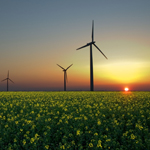
Principles of Sustainability
Chapter 6 - Energy Sustainability
Part 10 - Renewable Energy
 Renewable energy is not a new concept in our country or the world. Though clean energy techniques have long been ideas in society, our addiction to fossil fuels has not advanced the use of clean energy technologies, both in the past and present. However, the petroleum era is coming to a close, and our changing climate will no doubt impact our energy reality.
Renewable energy is not a new concept in our country or the world. Though clean energy techniques have long been ideas in society, our addiction to fossil fuels has not advanced the use of clean energy technologies, both in the past and present. However, the petroleum era is coming to a close, and our changing climate will no doubt impact our energy reality.
An example of this new reality is the state of New Jersey, a state not necessarily widely recognized as leading environmental change, yet it has become "a solar state" with the second most total photo-voltaics installed, with the third most per capita. New Jersey has mobilized its vast supply of industrial rooftops, and shortfalls in transmission and distribution infrastructure to generate local power with decreased fuel price risk, and peak generation capacity. Despite the capital costs, the very low long-term maintenance and operation costs, stability, and carbon-free nature of the energy resource accelerated this state as a leader in renewable energy.
New technologies, programs, and policies will likely become an increasingly important part of our world. As technologies and marketplace opportunities expand, we will find that renewable energy just makes sense. It makes sense for maintaining and improving our quality of life at a cost that will be increasingly competitive with fossil fuels, with a positive local impact of sustainable, distributed energy generation, and a global impact of reducing carbon loading to the atmosphere. It is a matter of time and technology, but renewable energy will be the foundation of our energy future.
Keywords
- solar energy
- wind energy
- hydropower
- ocean/marine energy
- biomass energy
- biofuel
- feedstock
- renewable resource
- non-renewable resource
- clean-tech
- green-energy
- sustainable energy
- distributed energy system
- carbon capture and sequestration
- demand growth
- supply challenges
- environmental constraints
- security of supply
- feed-in-tarriffs
- Renewable Portfolio Standards (RPS)
- Green Power Programs
- Property Assessed Clean Energy (PACE) Bonds
- Clean Renewable Energy Bonds (CREBs)
- investment tax credits
- production tax credits
Suggested Reading
- Renewables Global Status Report. REN21.
- Biofuels: Ethanol & Biodiesel. U.S. Energy Information Administration. U.S. Department of Energy.
- Hydropower. U.S. Energy Information Administration. U.S. Energy Information Administration. U.S. Department of Energy.
- Biomass — Renewable Energy from Plants and Animals. U.S. Energy Information Administration. U.S. Department of Energy.
- Wind. U.S. Energy Information Administration. U.S. Department of Energy.
- Geothermal. U.S. Energy Information Administration. U.S. Department of Energy.
- Solar. U.S. Energy Information Administration. U.S. Department of Energy.
- Special Report on Renewable Energy Sources and Climate Change Mitigation Summary Report. Intergovernmental Panel on Climate Change (2011).
(Photos credit: Guerito, 2005)
